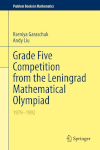- About MAA
- Membership
- MAA Publications
- Periodicals
- Blogs
- MAA Book Series
- MAA Press (an imprint of the AMS)
- MAA Notes
- MAA Reviews
- Mathematical Communication
- Information for Libraries
- Author Resources
- Advertise with MAA
- Meetings
- Competitions
- Programs
- Communities
- MAA Sections
- SIGMAA
- MAA Connect
- Students
- MAA Awards
- Awards Booklets
- Writing Awards
- Teaching Awards
- Service Awards
- Research Awards
- Lecture Awards
- Putnam Competition Individual and Team Winners
- D. E. Shaw Group AMC 8 Awards & Certificates
- Maryam Mirzakhani AMC 10 A Awards & Certificates
- Two Sigma AMC 10 B Awards & Certificates
- Jane Street AMC 12 A Awards & Certificates
- Akamai AMC 12 B Awards & Certificates
- High School Teachers
- News
You are here
Grade Five Competition from the Leningrad Mathematical Olympiad

Publisher:
Springer
Publication Date:
2020
Number of Pages:
178
Format:
Hardcover
Series:
Problem Books in Mathematics
Price:
54.99
ISBN:
978-3-030-52945-1
Category:
Problem Book
[Reviewed by , on ]
Frederic Morneau-Guerin
11/14/2021
This text, which is part of the Springer series Problem Books in Mathematics, presents the 83 demanding but stimulating problems that were administered between 1979 and 1992 as part of the Leningrad Mathematical Olympiads to Grade Five students (important clarification: the Soviet educational system was then divided into ten levels and students entered school at age 7). Translated from Russian to English by the authors (USSR-born Canadian mathematician Prof. Dr. Kseniya Garaschuk and Prof. Dr. Andy Liu), these problems are original in two ways: (1) they were developed specifically for the Leningrad Mathematical Olympiads; (2) They had not yet been translated to English for publication purposes.
Although the Leningrad Mathematical Olympiads – the oldest mathematical competition in the former Soviet Union – were launched in 1934, only problems from 1979 onward are presented in this work because the authors were unable to acquire the wordings of the problems from previous years. The choice to interrupt coverage in 1992 is due to the fact that it was the year when the name Leningrad was abandoned in the upheaval after the Soviet Union was dissolved and the city reverted to the name Saint Petersburg. The book’s organization is inspired by the now-classic problem resolution model by George Pólya and closely follows its four steps: (1) understand the problem; (2) make a plan; (3) carry out the plan; (4) look back.
In the first chapter (understand the problem), the wordings of the 83 problems are presented chronologically. In the second chapter (make a plan), the problems are set out again, but this time they are arranged based on the key underlying idea (for example, those centering on parity are combined, those making use of the pigeonhole principle, those involving the use of geometric configurations, those involving weighing, etc.). Problems are accompanied by a succinct discussion as well as an example or a reduction to a simpler problem serving as a hint. The third chapter (carry out the plan) marks the return to chronological order. Garaschuk and Liu present their own detailed solutions to each of the problems. Lastly, in the fourth chapter (look back), the book returns to subdivision by key ideas in order to formulate comments of a historical nature, present various generalizations and abstractions and touch on a few avenues for readers looking to venture further. This chapter – by far the most profound and enriching – is a significant original contribution. The authors stand out for their in-depth knowledge of the conceptual development in a historical perspective of what can appropriately be called recreational mathematics.
Although it goes without saying that this work is primarily intended for readers with some connection to the Mathematical Olympiads (such as organizers, question writers, people coaching participants, or even young participants themselves, although the solutions are more written with a view to mathematical accuracy rather than pedagogical concerns) – the interesting discussion presented in the fourth chapter alone is sufficient for anyone interested in recreational mathematics – to justify lingering over the book. However, it’s been known since the immense popular success of the Mathematical Games column from the well-known Martin Gardner (who is incidentally mentioned on several occasions) that this encompasses a potentially vast readership.
The only minor drawback: little care has gone into crafting an appealing book for readers. The layout does so little to showcase the content that you can go from one chapter to another almost without realizing it. The table of contents is too entangled to get a clear idea of what it contains. Lastly, indexes that allow readers to move easily between the various chapters are simply dropped into the space set aside to contain them with no additional clarifications on how to interpret them and with no reminder concerning how chapters are organized or the categorization of problems by type.
Frederic Morneau-Guerin is a professor in the Department of Education at Universite TELUQ. He holds a Ph.D. in abstract harmonic analysis.
See the publisher's website.
- Log in to post comments




